- Study on Structural Difference of Carbon Dot Synthesized from Polysaccharide with Different Functional Groups
*Department of Organic and Nano System Engineering, Konkuk University, Seoul 05029, Korea
**Current Address: Korea Polymer Testing & Research Institute, Seoul 02633, Korea- 폴리사카라이드의 기능기 차이에 따른 탄소점의 구조 발현 기구 연구
*건국대학교 공과대학 유기나노시스템공학과
**현소속: 한국고분자시험연구소Reproduction, stored in a retrieval system, or transmitted in any form of any part of this publication is permitted only by written permission from the Polymer Society of Korea.
In this study, carbon dots were synthesized using different polysaccharides via ionic-liquid based solution process. Using the polymer structure with same glucose unit but different functional groups, synthesized carbon dots exhibited different chemical structures and optical properties. The rheological properties of the solutions were deeply analyzed to study the structure develop mechanism of core structure and functional group of carbon dot. N-doped core structure was obtained when imidazole ring participated in structural formation. When polysaccharides with N-functional groups (acetamide group and amino group) was used as precursors, N-containing functional groups were developed. The structural formation mechanism of carbon dot regarding the structural difference of polysaccharides can be applicable to the other polymers and can be utilized as a platform for purpose-oriented structure development.
이온성 액체 내 폴리사카라이드의 용해 공정으로 탄소점을 제조하였다. 기본 골격은 동일하나 서로 다른 기능기를 갖는 4종의 폴리사카라이드를 사용하여 고분자의 구조적 차이에 의한 탄소점의 구조 형성의 차이를 분석하였다. 탄소점의 내/외부 구조의 발달을 설명하기 위해 고분자의 용해·분해 과정을 유변학적 거동을 통해 고찰하였다. 화학적/광학적 특성 분석 결과를 통해 탄소점으로의 재축합 과정 중 고분자 기능기의 다이폴 모먼트(dipole moment) 차이에 따라 질소 도핑된 내부 구조의 조절이 가능하며, 질소 기능기를 갖는 고분자를 사용할 경우 표면에 질소 기능기를 가지는 탄소점 구조가 발현됨을 확인하였다. 이러한 고찰은 타 고분자에 적용되어 목적 지향적 구조 발현을 위한 플랫폼으로 활용될 수 있을 것이다.
Keywords: polysaccharide, carbon dot, rheology, structural development, optical property.
- Polymer(Korea) 폴리머
- Frequency : Bimonthly(odd)
ISSN 0379-153X(Print)
ISSN 2234-8077(Online)
Abbr. Polym. Korea - 2023 Impact Factor : 0.4
- Indexed in SCIE
 This Article
This Article
-
2021; 45(6): 849-856
Published online Nov 25, 2021
- 10.7317/pk.2021.45.6.849
- Received on Apr 20, 2021
- Revised on Jun 18, 2021
- Accepted on Jul 9, 2021
 Correspondence to
Correspondence to
- Hyungsup Kim
-
Department of Organic and Nano System Engineering, Konkuk University, Seoul 05029, Korea
- E-mail: iconclast@konkuk.ac.kr









 Copyright(c) The Polymer Society of Korea. All right reserved.
Copyright(c) The Polymer Society of Korea. All right reserved.